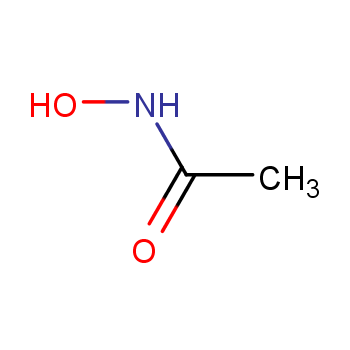 |
Acetohydroxamic acid (Acetohydroxamicacid), also known as acetohydroxamic acid, is widely used in medicine, animal husbandry, agriculture, environmental protection, metallurgy, etc. In the feed industry, it is used as a rumen microbial urease inhibitor and used as a feed additive for ruminants; in medicine, it is a competitive inhibitor of urease, with the trade name of Junshitong; in the metallurgical industry, it is used as a chelating agent and extraction agent for the extraction of metal ions. and identification, etc.
At present, most of the synthesis methods of Acetohydroxamic acid are chemical synthesis. Su Lanhui and Jiang Xiangyang used ethyl acetate and hydroxylamine hydrochloride in methanol as solvent in "Research on Acetohydroxamic acid Synthesis Process" (China Feed) Acetohydroxamic acid is prepared by reaction in the system. Utilizing the characteristics of hydroxylamine hydrochloride to decompose free hydroxylamine under alkaline conditions, Acetohydroxamic acid is synthesized from hydroxylamine hydrochloride and ethyl acetate in an alkaline solvent system. The yield is about 80%. The main reaction process is as follows:
CH3COOC2H5+NH2OH→CH3CONHOH+C2H5OH
Chinese patent application number: 201010514343.1, application date: October 2010 On March 21, the invention was named "Acetohydroxamic acid preparation process" and adopted a new synthesis method. First, dissolve hydroxylamine hydrochloride in water, then add liquid caustic soda to neutralize the hydrochloric acid. The hydrochloric acid in the hydroxylamine frees the hydroxylamine, and then adds acetamide and Using the catalyst 4-dimethylaminepyridine, a synthesis reaction can occur to obtain an Acetohydroxamic acid aqueous solution. The aqueous solution is concentrated to dryness under vacuum to obtain Acetohydroxamic acid crystals with a mass percentage of more than 80%.
Chinese patent application number: 02114593.8, application date: May 24, 2002, the name of the invention is "Preparation process of Acetohydroxamic acid". Mix hydroxylamine hydrochloride and methyl acetate in a flask, and then add the solid Use a base as a catalyst to neutralize the hydrochloric acid brought by hydroxylamine hydrochloride, and then add the same volume of alcohol as methyl acetate into the flask as a solvent. A synthesis reaction can occur to obtain Acetohydroxamic acid, and the purity can reach 80%. It can also be compounded. 5% of products suitable for feed use.
In the above production process, the collection of raw materials and the control of temperature during the production process have met the cost control and safety requirements, but the yield and purity issues have still not been significantly improved, and the yield has not been improved. Propose effective solutions to core issues such as purity and purity.
The present invention provides a synthesis method of Acetohydroxamic acid.
The synthesis method of Acetohydroxamic acid uses hydroxylamine sulfate and ethyl acetate as raw materials, and a mixture solution of sodium ethoxide and ethanol as a catalyst to synthesize Acetohydroxamic acid;
Specifically , the synthesis method of Acetohydroxamic acid includes:
Add hydroxylamine sulfate in the reactor, add the catalyst dropwise at room temperature, stir, and after the dropwise addition is completed, a mixed solution with precipitation will be obtained, and continue to dropwise add ethyl acetate, After the reaction is completed, the reaction should be maintained for several hours. The reaction temperature should be maintained at 20°C to 35°C. After the reaction is completed, while continuing to stir, slowly add concentrated sulfuric acid to adjust to the end point pH = 6, filter and concentrate to obtain a concentrated viscous liquid, which can be crystallized with a mixed solvent. , dry to obtain Acetohydroxamic acid finished product. If a higher purity product is required, recrystallization can continue;
To prepare Acetohydroxamic acid, first prepare free hydroxylamine through neutralization reaction, and then combine free hydroxylamine with Ethyl acetate undergoes amidation reaction. Since this reaction is a reversible reaction, a base is added to the reaction solution to generate the sodium salt of Acetohydroxamic acid to promote the forward reaction. Finally, hydrochloric acid is added for acidification to obtain Acetohydroxamic acid.
The main chemical reaction equation is as follows:
Free hydroxylamine: (NH2OH)2·H2SO4+2CH3CH2ONa→2NH2OH+Na2SO4
Amidation reaction: 
Salt formation reaction: CH3CONHOH+CH3CH2ONa→CH3CONHONa+CH3CH2OH
Acidification reaction: CH3CONHONa+H2SO4→CH3CONHOH+Na2SO4
The catalyst is an ethanol solution of sodium ethoxide;
The ethanol in the ethanol solution of sodium ethoxide of the catalyst is Absolute ethanol;
The mass percentage of sodium ethoxide in the ethanol solution of the catalyst sodium ethoxide is 5% to 50%, and the preferred mass percentage of sodium ethoxide in the ethanol solution of the catalyst sodium ethoxide is 10% ~40%;
The source of the ethanol solution of the catalyst sodium ethoxide is commercially available products or homemade using conventional methods;
The dripping time of the ethanol solution of the catalyst sodium ethoxide is: 10min~2h;
The molar ratio of sodium ethoxide to hydroxylamine sulfate in the ethanolic solution of sodium ethoxide of the catalyst is 1.5-10:1, and preferably the molar ratio of sodium ethoxide to hydroxylamine sulfate in the catalyst is 2-6 :1, more preferably the molar ratio of sodium ethoxide and hydroxylamine sulfate in the catalyst is 4.5:1;
The molar ratio of ethyl acetate and hydroxylamine sulfate is 1.0~3.0:1, preferably ethyl acetate and sulfuric acid The molar ratio of hydroxylamine is 1.1-2.5:1, and the more preferred molar ratio of ethyl acetate and hydroxylamine sulfate is 2.2:1;
The dripping time of ethyl acetate is 0.5-2h;
The mixed solvent used for crystallization is chloroform and absolute ethanol;
The volume ratio of chloroform to absolute ethanol in the mixed solvent used for crystallization is 1:1 to 10:1 , preferably the volume ratio of chloroform and absolute ethanol in the mixed solvent for crystallization is 5:1 to 8:1;
The volume ratio of the mixed solvent for crystallization to the concentrated solution is 4 to 20: 1.
Acetohydroxamic acid is synthesized using a mixture solution of sodium ethoxide and ethanol as a catalyst, and hydroxylamine sulfate and ethyl acetate as raw materials.
Add 16.4g (0.1mol) of hydroxylamine sulfate into the reactor, add 153.0g of 20% ethanol solution of sodium ethoxide dropwise at room temperature, where the molar ratio of sodium ethoxide to hydroxylamine sulfate is 4.5:1, stir, about After 1 hour of dropwise addition, a precipitated mixed solution will be obtained. Continue to add 20.3g (0.23mol) of ethyl acetate dropwise. It will be completed in about 1 hour. The reaction will take 2 hours. The reaction temperature should be maintained at 25°C to 30°C. After the reaction is completed, continue stirring. Slowly add concentrated sulfuric acid to adjust to the endpoint pH = 6, filter and concentrate to obtain a concentrated liquid of about 10 ml. Use 100 ml of a mixed solvent of chloroform and ethanol to crystallize with a volume ratio of 8:1 to obtain 14.8 g of needle-like crystals of Acetohydroxamic acid. Yield 98.6%. Continue to use chloroform and ethanol volume ratio 5:1 to recrystallize twice. The yield is 84.2% and the purity is 99.0%.
 |